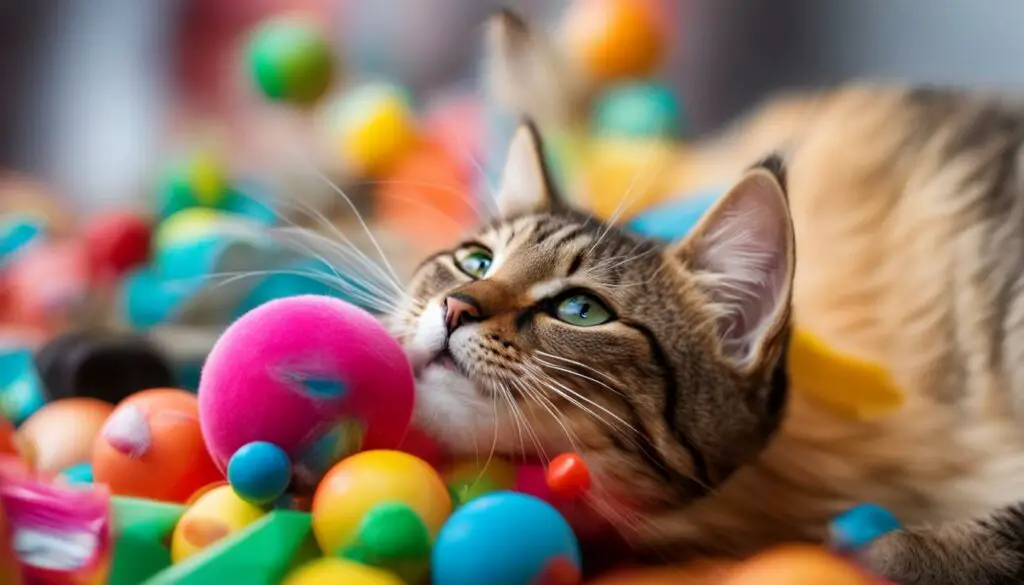Have you ever wondered why your cat opens his mouth when playing? It’s a curious behavior that many cat owners have observed. But what does it mean? Is there a specific reason behind it? Let’s dive into the fascinating world of cat behavior and explore the phenomenon of open-mouth play.
When cats engage in play, they often exhibit a behavior known as the Flehmen response. This behavior involves them opening their mouths slightly and inhaling through their mouth while playing. But why do they do this? The answer lies in their highly evolved sense of smell and their need to gather more information about their surroundings.
The Flehmen response is a natural behavior where cats analyze scents by pulling back their upper lip and inhaling through their mouth. This allows the scent to reach the vomeronasal organ located in the roof of their mouth. The vomeronasal organ acts as a combination of taste and smell receptors, helping cats gather more information about their environment.
So when your cat opens his mouth while playing, he is actually using his sense of smell to analyze the scents around him. It’s a way for him to gather more information about his play environment and the other animals in it. It’s a fascinating behavior that showcases the unique adaptations that cats have developed over time.
Key Takeaways:
- The behavior of cats opening their mouths while playing is known as the Flehmen response.
- The Flehmen response allows cats to gather more information about their environment and the scents around them.
- This behavior is not exclusive to playing and can also be observed when cats are exploring new scents or investigating their environment.
- The Flehmen response is more commonly seen in male cats as part of their mating behavior.
- Cats have a more developed Flehmen response compared to other animals, with more receptors in their vomeronasal organ.
What is the Flehmen Response in Cats?
The Flehmen response is a fascinating behavior seen in cats, where they open their mouths slightly and inhale through their mouth. This behavior allows them to analyze scents more intensely, as the scent is directed to the vomeronasal organ located in the roof of their mouth. The vomeronasal organ is a group of sensory cells that play a role in processing scent information. Cats use the Flehmen response to gather more information about their environment and the other animals in it.
This behavior is not exclusive to playing or interacting with scents, as cats may also exhibit the Flehmen response when exploring new scents or investigating their environment. It is a way for them to enhance their sense of smell and gather more information about their surroundings. The Flehmen response is a natural and instinctual behavior in cats, showcasing their ability to communicate and navigate their environment through scent analysis.
The Flehmen response is a natural and instinctual behavior in cats, showcasing their ability to communicate and navigate their environment through scent analysis.
In comparison to other animals, cats have a more developed Flehmen response, with more receptors in their vomeronasal organ. This allows them to gather more precise information about their environment and communicate effectively with other cats. Although the Flehmen response is commonly seen in male cats as part of their mating behavior, it can also be observed in females. Female cats may exhibit the Flehmen response to keep track of their kittens and monitor their well-being.
| Cat Behavior | Flehmen Response |
|---|---|
| Male Cats | Used in mating behavior to determine compatibility and timing for mating. |
| Female Cats | May use it to monitor their kittens and ensure their well-being. |
The Flehmen response in cats is a captivating behavior that showcases their unique abilities in scent analysis and communication. By understanding this behavior, cat owners can gain insights into their feline companions’ preferences and reactions to different scents, strengthening their bond and providing a more enriched environment for their cats.
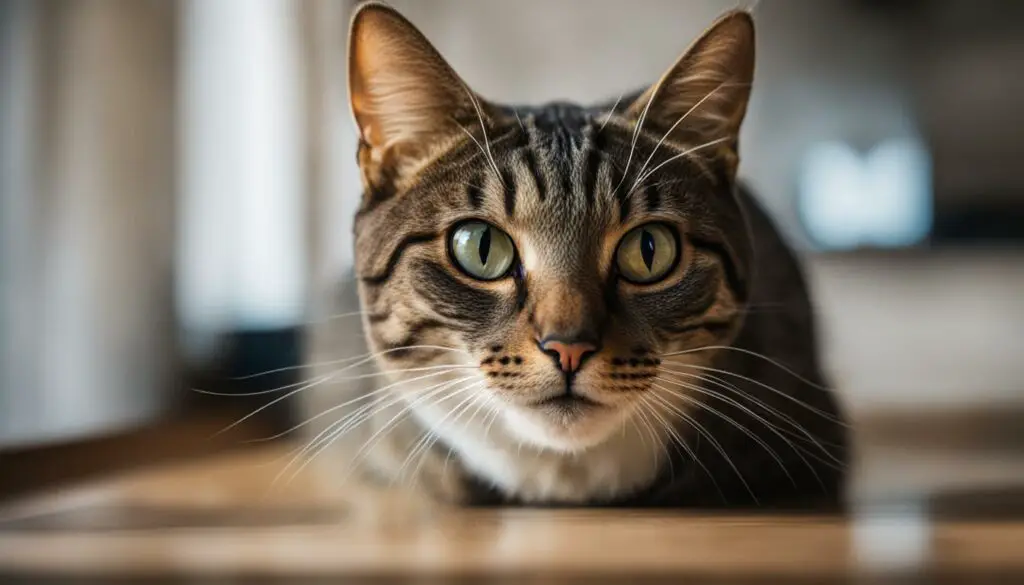
Why Do Cats Open Their Mouths When Playing?
Cats open their mouths when playing as part of their natural behavior. It is a way for them to enhance their play experience and communicate with other cats. Opening their mouths allows cats to gather more information about their surroundings and the scents around them. This behavior is not exclusive to playing, as cats may also exhibit it when exploring new scents or investigating their environment. It is a form of communication and sensory exploration for cats.
When cats open their mouths while playing, it can be seen as a sign of excitement and engagement. It is their way of expressing their enthusiasm and involvement in the play session. This behavior is often accompanied by other playful movements, such as pouncing, chasing, and batting. It is a way for cats to fully immerse themselves in the play experience and interact with their environment.
The act of opening their mouth allows cats to gather more information about the scents present in their surroundings. Cats have a highly developed sense of smell, and by opening their mouths, they can analyze the scents more effectively. This behavior is similar to how humans might take a deep breath to better experience a pleasant smell. By opening their mouths, cats can gather more sensory information and further engage with their environment.
Why Do Cats Open Their Mouths When Playing?
Opening their mouths while playing is a natural and instinctual behavior for cats. It not only enhances their play experience but also allows them to communicate with other cats and gather more information about their environment. By understanding and appreciating this behavior, cat owners can gain insights into their cats’ preferences and reactions during playtime.
| Signs of Cat Play | Meaning |
|---|---|
| Pouncing and chasing | Engagement and hunting behavior |
| Batting and swatting | Exploratory and playful behavior |
| Opening mouth | Enhanced sensory experience and communication |
By observing these signs of play behavior, cat owners can better understand their cats’ needs, preferences, and overall enjoyment during playtime. It is important to provide cats with opportunities for play and stimulation to ensure their physical and mental well-being.
The Flehmen Response in Male Cats vs. Female Cats
Male and female cats exhibit different behaviors when it comes to the Flehmen response. Male cats are more likely to display this behavior as part of their mating rituals. They use the Flehmen response to assess the pheromones of potential mates and determine if they are ready to mate. By analyzing the scents, male cats can gauge compatibility and timing, ensuring successful reproduction. On the other hand, female cats may use the Flehmen response to keep track of their kittens and monitor their well-being. This behavior allows them to gather information about their offspring’s scent and overall health. While the Flehmen response is more commonly observed in males, females can also exhibit this behavior as part of their natural instincts.
To further understand this distinction, let’s take a look at the differences in male and female cat behavior during the Flehmen response:
| Behavior | Male Cats | Female Cats |
|---|---|---|
| Mating Behavior | Use the Flehmen response to assess potential mates and determine compatibility and timing for mating. | May use the Flehmen response to monitor kittens and assess their well-being. |
| Frequency | More commonly observed during mating periods. | Can be observed during and after giving birth to kittens. |
| Purpose | Determine mating readiness and compatibility. | Monitor kittens and gather information about their scent. |
It’s important to note that while male cats show a higher frequency of the Flehmen response, it doesn’t mean that female cats cannot exhibit this behavior. Female cats may still use the Flehmen response to gather information about their surroundings and communicate with other cats. The Flehmen response is a fascinating behavior that showcases the unique instincts and behaviors of male and female cats.
The Flehmen Response in Cats and Other Animals
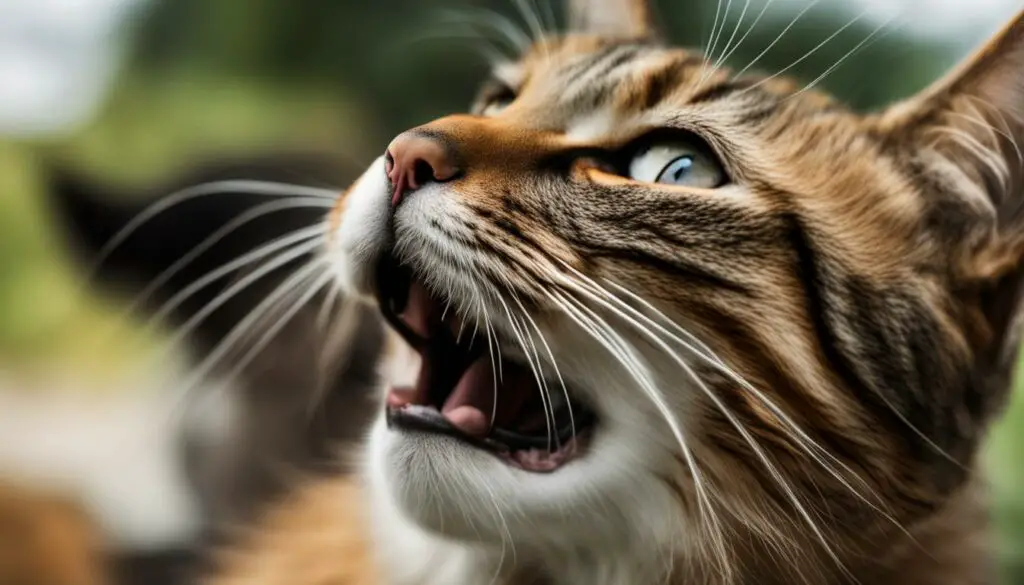
The Flehmen response, where cats open their mouths to analyze scents, is not exclusive to our feline friends. Many other animals also exhibit this behavior, showcasing its importance in animal communication and gathering information about the environment. Some animals that display the Flehmen response include dogs, camels, llamas, goats, horses, tapirs, rhinos, rams, elk, giraffes, buffalos, hedgehogs, and even big cats like lions and tigers.
This behavior is a fascinating aspect of animal behavior and is particularly pronounced in cats due to their highly developed sense of smell. Cats have more receptors in their vomeronasal organ, the sensory organ responsible for processing scent information. This allows them to gather more detailed information from the scents they encounter, aiding in their understanding of their surroundings and interactions with other animals.
Observing the Flehmen response in cats and other animals can provide valuable insights into their behavior and communication. By recognizing and understanding this behavior, we can deepen our appreciation for the natural instincts and adaptations that animals possess.
Comparative Table: The Flehmen Response in Cats and Other Animals
| Animal | Flehmen Response |
|---|---|
| Cats | Highly developed Flehmen response due to more receptors in the vomeronasal organ |
| Dogs | Exhibit the Flehmen response, but to a lesser extent compared to cats |
| Horses | Display the Flehmen response as a way to gather information about potential mates |
| Giraffes | Use the Flehmen response to gather information about scents left by other giraffes |
| Buffalos | Show the Flehmen response to analyze scents in their environment |
The Flehmen response in cats and other animals is a testament to the fascinating nature of animal behavior. It highlights their ability to communicate and gather information through scent analysis, providing valuable insights into their natural instincts and adaptations.
The Evolution of the Flehmen Response: A Window into Human and Cat Evolutionary History
The Flehmen response, displayed by cats when opening their mouths, is not only a fascinating behavior but also offers a glimpse into the evolutionary history of both humans and cats. This instinctual behavior has been preserved in cats as a way to gather more precise information about their environment. While humans also possessed the receptors in their vomeronasal organ at some point, they were lost over time, making the Flehmen response a unique adaptation for cats.
Understanding the history of the Flehmen response sheds light on the intricate relationship between humans and cats throughout evolutionary time. It showcases the diverse ways in which animals, including cats, have developed specialized behaviors to navigate and interpret their surroundings. The Flehmen response, with its origins in scent analysis, reveals the complexity and richness of the natural world.
The evolutionary significance of the Flehmen response extends beyond cats. This behavior is also observed in a range of other animals, such as dogs, camels, and giraffes, indicating its importance in species survival and adaptation. Cats, however, have a more developed Flehmen response compared to many other animals, with a higher number of receptors in their vomeronasal organ. This enhanced sensitivity to scents highlights their unique ability to communicate and gather information about their surroundings.
| Cats and the Evolution of the Flehmen Response | Humans and the Loss of the Flehmen Response |
|---|---|
| The Flehmen response is a preserved behavior in cats, allowing them to gather precise information about their environment. | Humans, at some point, had the receptors in their vomeronasal organ, but they became lost over time in the course of evolution. |
| This behavior showcases the evolutionary history of animals and their unique adaptations. | Understanding the loss of the Flehmen response in humans reveals the complexities of evolutionary changes and the diversity of species adaptations. |
| The Flehmen response is a testament to the intricate relationship between humans and cats throughout history. | Humans and cats share a common evolutionary history, with cats retaining the Flehmen response. |
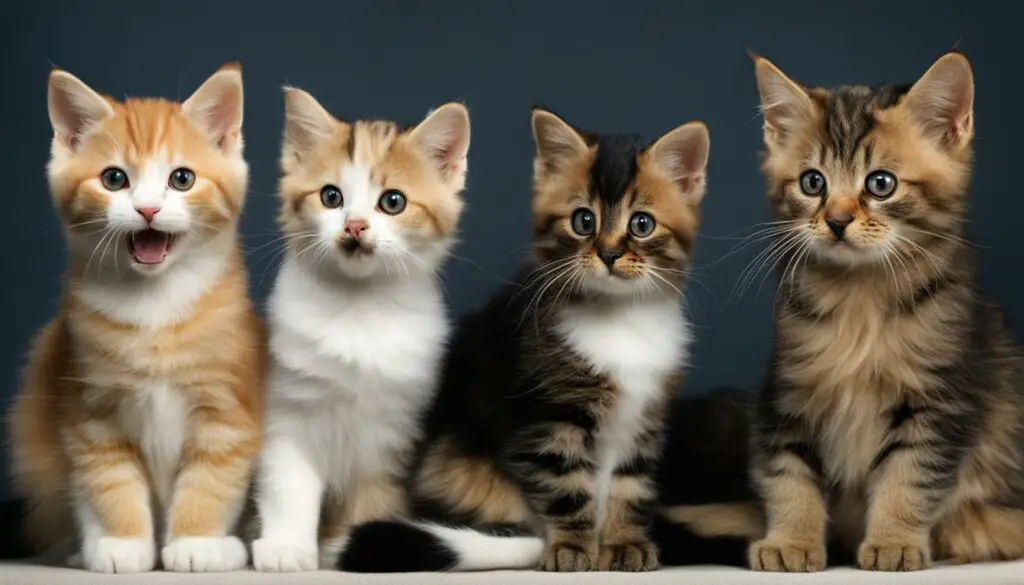
“The Flehmen response is not only an intriguing behavior in cats, but it also provides valuable insights into the evolutionary history of both humans and cats. It reflects the adaptations animals have developed to navigate and interpret their surroundings, showcasing the diverse range of behaviors in the natural world.”
The Connection Between Cats and Humans
The presence of the Flehmen response in cats is a reminder of the deep connection between humans and animals. Throughout history, cats have held a special place in human society, offering companionship and capturing our curiosity. The shared evolutionary history evokes a sense of wonder and invites us to explore further the mysteries of feline behavior.
By delving into the intricacies of the Flehmen response and its evolutionary significance, we gain a deeper appreciation for the marvels of nature. The unique behaviors exhibited by cats, including the Flehmen response, serve as a constant source of fascination and remind us of the complexity and beauty of the natural world.
Open-Mouthed Cats and the Flehmen Response
When it comes to cats opening their mouths, it’s important to understand the behavior behind it. In many cases, an open-mouthed cat is demonstrating what is known as the Flehmen response. This natural behavior allows cats to gather more information about scents and communicate with other cats. The Flehmen response is triggered when a cat pulls back its upper lip and inhales, allowing scents to reach the vomeronasal organ located in the roof of their mouth.
It’s crucial to differentiate between the Flehmen response and other potential reasons for a cat to keep their mouth open. While the Flehmen response is harmless and part of a cat’s instinctual behavior, persistent open-mouth breathing or signs of respiratory distress could indicate a medical problem. If a cat exhibits these symptoms, it is important to consult a veterinarian for a proper diagnosis.
| Open-Mouthed Cat Behavior | Flehmen Response |
|---|---|
| Curiosity and exploration | Enhanced scent analysis |
| Playful behavior | Communication with other cats |
| Investigation of new scents | Sensory exploration |
“The Flehmen response is a natural behavior that allows cats to gather more information about their environment and communicate with other cats. It’s fascinating to observe how cats use their sense of smell in such a unique way.”
By understanding the open-mouthed behavior in cats and recognizing when it signifies the Flehmen response, cat owners can gain insights into their feline companions’ preferences, reactions to scents, and overall communication. However, it’s always important to monitor any changes in a cat’s behavior and seek veterinary care if there are any signs of distress or illness.
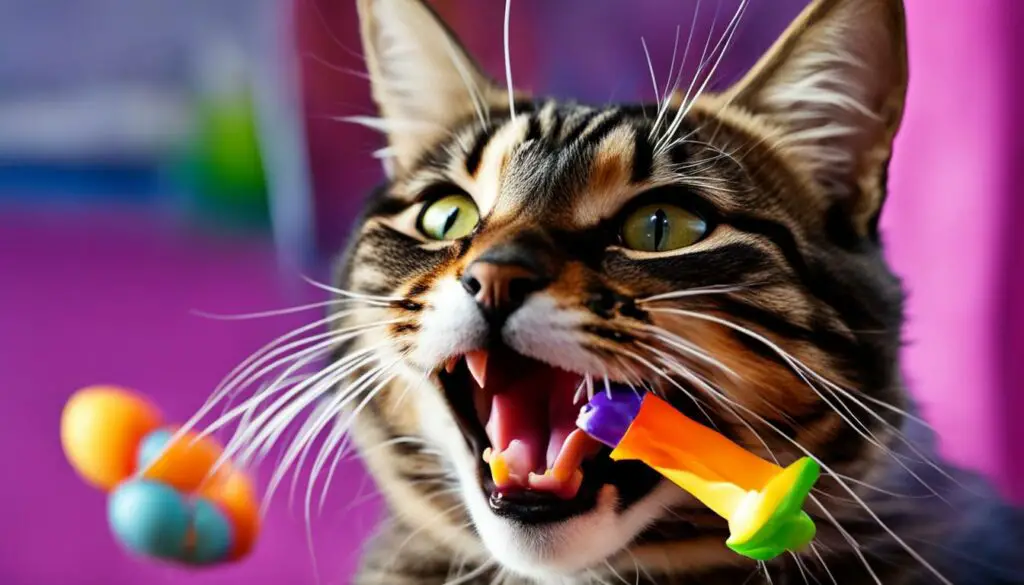
Possible Reasons for Open-Mouthed Cats:
- Curiosity and exploration
- Playful behavior
- Investigation of new scents
Remember, the Flehmen response is a normal part of a cat’s behavior and should not be a cause for concern. It’s just one of the many fascinating ways our feline friends interact with the world around them.
Health Problems and Open-Mouthed Cats
While most cases of open-mouthed cats can be attributed to the Flehmen response, it is essential to be aware of potential health problems that may cause this behavior. Cats may keep their mouth open due to various reasons, including bacterial or viral infections, allergies, tumors in the nasal cavity, or mouth diseases like stomatitis or gingivitis. It’s important to observe your cat’s overall behavior and look for any other accompanying symptoms. If your cat exhibits consistent open-mouth breathing or shows signs of respiratory distress such as wheezing, coughing, or difficulty breathing, it is necessary to seek veterinary attention.
| Common Health Problems Associated with Open-Mouthed Cats | Symptoms |
|---|---|
| Bacterial or viral infection | Open mouth breathing, sneezing, nasal discharge, fever, lethargy |
| Allergies | Open mouth breathing, itching, sneezing, watery eyes, skin rashes |
| Tumors in the nasal cavity | Open mouth breathing, nasal discharge, facial swelling, weight loss |
| Mouth diseases (stomatitis, gingivitis) | Open mouth breathing, drooling, bad breath, difficulty eating |
It’s important to remember that open-mouth breathing in cats can be a sign of underlying health issues that require professional diagnosis and treatment. Early intervention and proper veterinary care can help manage these conditions effectively and improve your cat’s quality of life. Therefore, if you notice any concerning symptoms or changes in your cat’s behavior, it is always best to consult with your veterinarian for proper evaluation and guidance.
“A vigilant eye on your cat’s health and timely veterinary care can prevent complications and ensure a long and happy life for your feline friend.”
Panting in Cats and When to Seek Veterinary Care
When it comes to cats, panting is not a behavior that should be taken lightly. While dogs commonly pant to regulate their body temperature, panting in cats is often a sign of respiratory distress and should be cause for concern. If you notice your cat panting, it is crucial to assess the situation and seek veterinary care if necessary.
Panting in cats can be caused by a variety of factors, including heat stroke, heart disease, respiratory infections, or obstructions in the airway. It can also be a symptom of underlying health conditions such as asthma or pneumonia. Additionally, stress or anxiety can also cause a cat to pant. However, if the panting is excessive, prolonged, or accompanied by other concerning symptoms, it is critical to consult a veterinarian for a proper diagnosis and treatment plan.
“Panting in cats is a sign of respiratory distress and should be taken seriously.”
Some signs that indicate a cat is struggling to breathe and may require immediate veterinary care include difficulty breathing, a lowered head with elbows pulled away from the body, apathy, coughing, or bluish gums. If you observe these symptoms, it is important to remain calm and gently place the cat in a carrier for transport to the veterinarian.
Table: Common Causes of Panting in Cats
| Cause | Symptoms |
|---|---|
| Heat Stroke | Excessive panting, drooling, weakness, vomiting |
| Heart Disease | Difficulty breathing, coughing, fatigue, rapid breathing |
| Respiratory Infections | Coughing, sneezing, nasal discharge, fever |
| Airway Obstruction | Labored breathing, choking, gagging, coughing |
| Asthma | Wheezing, coughing, difficulty breathing, lethargy |
Remember, panting in cats is not a behavior to dismiss or ignore. It is always better to err on the side of caution and seek veterinary care if you have any concerns about your cat’s breathing or overall health. By acting promptly, you can ensure your feline companion receives the necessary care and treatment to address any underlying issues and promote their well-being.
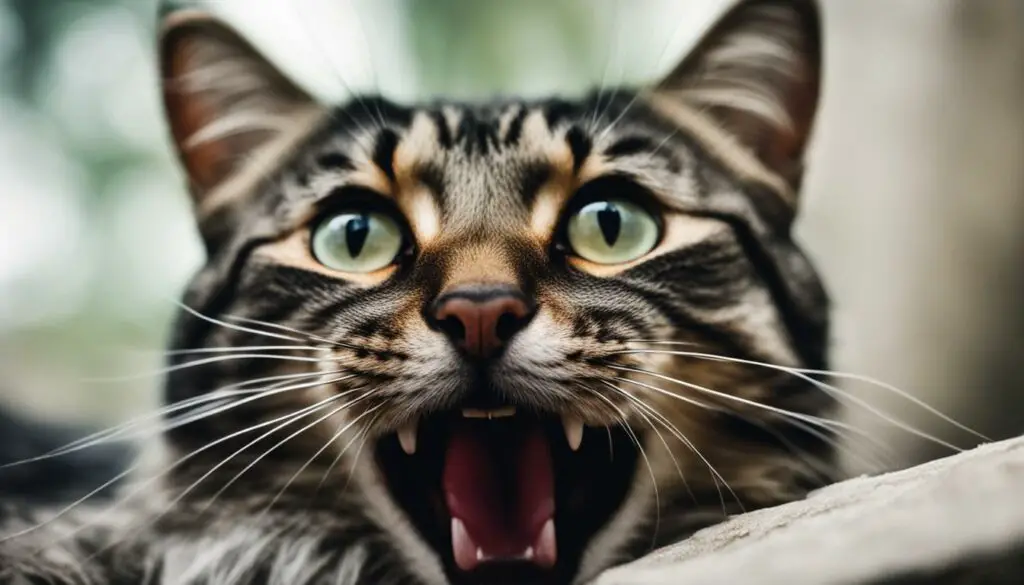
The Flehmen Response as Natural Cat Behavior
Understanding cat behavior is essential for any cat owner. One fascinating behavior that cats display is the Flehmen response. This natural behavior involves cats opening their mouths slightly and inhaling through their mouth to analyze scents. It is a unique form of communication and sensory exploration for cats.
The Flehmen response allows cats to gather more information about their surroundings and the other animals in their environment. By pulling back their upper lip and inhaling, the scent travels to the vomeronasal organ located in the roof of their mouth. This behavior is similar to taste and smell combined, allowing cats to gain a deeper understanding of the scents they encounter.
Cat owners can observe and interpret the Flehmen response to gain insights into their feline companions’ preferences and reactions to different scents and stimuli. It is a way for cats to navigate and understand their environment, enhancing their overall well-being. By recognizing this natural behavior, cat owners can strengthen the bond with their cats and provide them with a stimulating and enriching environment.
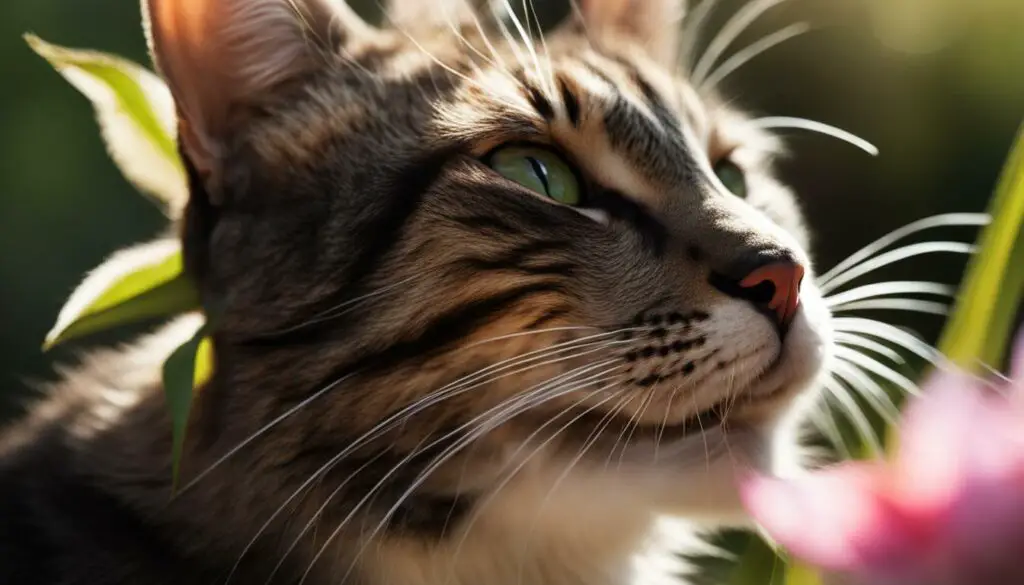
The Flehmen Response: A Form of Cat Body Language
The Flehmen response is just one aspect of a cat’s body language. Cats use various cues to communicate their needs and emotions. By observing their body language, including the Flehmen response, cat owners can better understand what their cats are trying to convey. This understanding can contribute to a harmonious relationship between humans and felines.
It’s important to note that the Flehmen response should not be confused with other behaviors, such as excessive panting or open-mouthed breathing, which can indicate potential health issues. If a cat exhibits consistent open-mouth breathing or other concerning symptoms, it is crucial to seek veterinary attention.
In summary, the Flehmen response is a natural behavior that allows cats to analyze scents and communicate with other cats. By recognizing and appreciating this behavior, cat owners can enhance their understanding of their feline companions and provide them with a nurturing and enriched environment.
The Fascinating World of Cat Communication
Understanding cat communication goes beyond the meows and purrs. Cats have their own intricate system of body language that allows them to convey their needs, emotions, and intentions. The Flehmen response, which we explored in the previous sections, is just one piece of the puzzle.
Cat communication is a visual language that includes various signals such as tail positions, ear positions, facial expressions, and body postures. By observing and interpreting these cues, we can gain a deeper understanding of our feline companions.
For example, a cat with a straight, upright tail may be feeling confident and friendly. On the other hand, a cat with a puffed-up tail and arched back may be indicating fear or aggression. Similarly, a cat showing half-closed eyes and slow blinks is displaying trust and relaxation.
“Understanding cat communication goes beyond the meows and purrs.
It’s important to pay attention to the context in which these signals occur. A cat may display different behaviors depending on the situation they are in. By being attuned to our cats’ body language, we can better meet their needs and provide a safe and supportive environment.
So, the next time your cat opens its mouth while playing or exploring scents, remember that it is just one part of their intricate communication repertoire. By observing their body language as a whole, we can strengthen our bond with them and ensure their well-being.
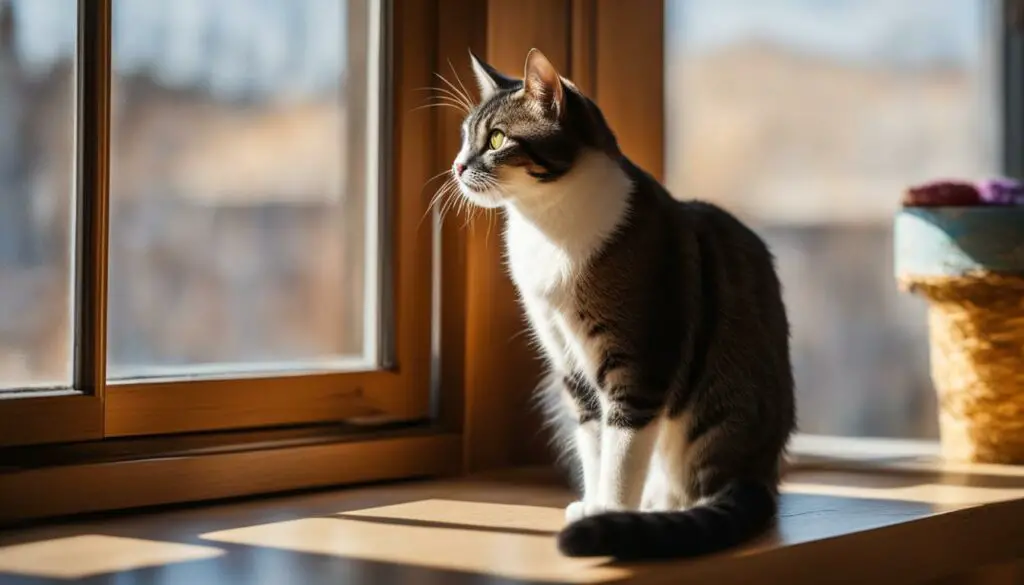
| Common Cat Communication Signals | Meaning/Interpretation |
|---|---|
| Tail held high and straight | Confidence and friendliness |
| Puffed-up tail and arched back | Fear or aggression |
| Half-closed eyes and slow blinks | Trust and relaxation |
| Ears forward and alert | Curiosity and attentiveness |
| Flattened ears and dilated pupils | Agitation or fear |
| Quick, jerky tail movements | Agitation or excitement |
Remember, every cat is unique, and their communication signals may vary. It is essential to observe your cat’s individual body language patterns and take into account their overall behavior and environment when interpreting their signals.
The Enigmatic World of Cats
Cats have always fascinated us with their mysterious behavior and unique ways of interacting with the world. From their graceful movements to their inscrutable expressions, cats captivate our attention and pique our curiosity. Whether they’re curling up in a sunbeam, chasing invisible prey, or perching on high surfaces, cats possess an enigmatic charm that continues to intrigue and delight us.
In the realm of feline behavior, there are countless mysteries waiting to be unraveled. Why do cats stare at empty spaces with intense focus? What secrets lie behind their mesmerizing tail flicks and subtle ear twitches? And what about their affinity for cardboard boxes and tight spaces? These enigmatic behaviors, among many others, have left cat lovers and researchers alike wondering about the hidden motivations and meanings behind them.
Exploring the enigmatic world of cats is a journey filled with fascination and wonder. It involves deciphering their body language, decoding their vocalizations, and understanding the intricate ways they communicate with each other and with us. By immersing ourselves in the study of feline behavior, we can gain insights into the inner workings of these captivating creatures and forge a deeper connection with our beloved feline companions.
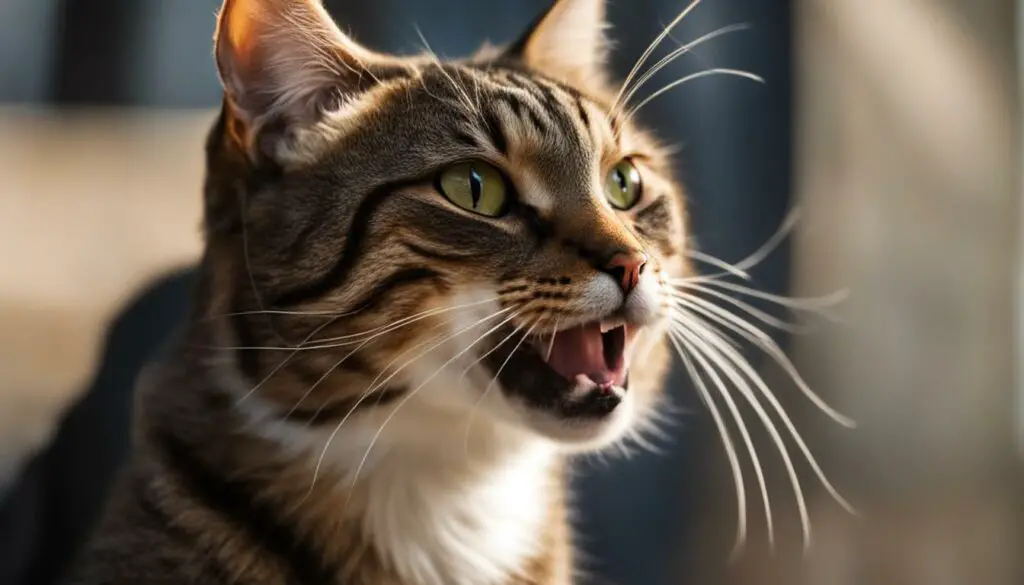
The Intricacies of Feline Communication
One of the most captivating aspects of the enigmatic world of cats is their unique system of communication. While cats possess a wide array of vocalizations, including purrs, meows, chirps, and hisses, their body language speaks volumes as well. The position of their ears, the movement of their tail, and the dilation of their pupils all convey rich information about their mood, intentions, and level of comfort.
Understanding cat communication is like learning a secret code. By observing their subtle cues and responding appropriately, we can navigate the intricate landscape of their emotions and build stronger bonds with our feline friends.
Additionally, cats have a remarkable ability to interpret and respond to our own body language and vocal cues. Their keen senses allow them to pick up on subtle shifts in our tone of voice, facial expressions, and physical gestures. This mutual understanding between humans and cats is the foundation for the deep and meaningful relationships we cultivate with these enigmatic creatures.
| Enigmatic Cat Behaviors | Mysterious Interpretations |
|---|---|
| Tail flicking | Sign of agitation or excitement |
| Kneading | Reminiscent of kitten nursing behavior or a sign of contentment |
| Pawing at water | An attempt to test or play with the water |
| Nighttime zoomies | Excessive energy release or play behavior |
The enigmatic world of cats is filled with captivating behaviors and endless discoveries. By observing, questioning, and embracing the mysteries of feline behavior, we can immerse ourselves in their fascinating world and deepen our appreciation for these extraordinary creatures.
Conclusion
Understanding cat behavior and communication is key to building a strong and harmonious relationship with our feline friends. The Flehmen response, where cats open their mouths during play or when investigating scents, is a natural behavior that allows them to gather information about their environment. By recognizing this behavior as part of the cat’s instinctual repertoire, we can better interpret their preferences and reactions to different smells and stimuli.
While the Flehmen response is generally harmless, it’s important to differentiate it from potential health issues that may require veterinary attention. Consistent open-mouth breathing or other respiratory distress symptoms should be taken seriously and promptly addressed by a veterinarian. By being attentive to our cat’s overall well-being, we can ensure their long-term health and happiness.
Observing and interpreting the Flehmen response, along with other forms of cat communication, allows us to deepen our understanding of our feline companions. From their mysterious ways to their unique body language, cats have an enchanting world that we can explore. By delving into the intricacies of cat behavior, we can further strengthen the bond between ourselves and our furry companions.
So, the next time you see your cat open their mouth during play or when sniffing around, remember that it’s their way of immersing themselves in the world of scents and sharing their experiences with you. Embrace their enigmatic behaviors, learn their language, and unravel the captivating mysteries that make cats truly fascinating creatures.
FAQ
Why does my cat open his mouth when playing?
Cats open their mouths while playing as part of their natural behavior known as the Flehmen response. This behavior allows them to analyze scents by pulling back their upper lip and inhaling through their mouth, gathering more information about their environment. It is a way for cats to enhance their play experience and communicate with other cats.
What is the Flehmen response in cats?
The Flehmen response in cats is a natural behavior where cats open their mouths slightly and inhale through their mouth to analyze scents. This allows the scent to reach the vomeronasal organ located in the roof of their mouth, which helps them gather more information about their environment and the other animals in it.
Why do cats open their mouths when playing?
Cats open their mouths when playing as a way to gather more information about their surroundings and the scents around them. This behavior is not exclusive to playing, as cats may also exhibit it when exploring new scents or investigating their environment. It is a form of communication and sensory exploration for cats.
What is the difference between the Flehmen response in male cats and female cats?
Male cats are more likely to exhibit the Flehmen response as part of their mating behavior, using it to determine compatibility and timing for mating. Female cats, on the other hand, may use the Flehmen response to keep track of their kittens and monitor their well-being. While the Flehmen response is more commonly seen in males, it can also be observed in females as a way for cats to gather information about their surroundings and communicate with other cats.
Do other animals exhibit the Flehmen response?
Yes, many other animals exhibit the Flehmen response, including dogs, camels, llamas, goats, horses, tapirs, rhinos, rams, elk, giraffes, buffalos, hedgehogs, and even big cats like lions and tigers. This behavior is a way for animals to gather more information about their environment and communicate with others of their species. Cats have a stronger Flehmen response compared to other animals, with more receptors in their vomeronasal organ.
How does the Flehmen response relate to the evolutionary history of animals?
The Flehmen response is believed to have evolved as a way for animals to gather more precise information about their environment. Humans, at some point in their evolutionary history, also had these receptors in their vomeronasal organ but lost them over time. Cats, with their more developed sense of smell, still rely on the Flehmen response to gather information. This behavior showcases the evolutionary history of animals and the unique adaptations they have developed.
Are open-mouthed cats always exhibiting the Flehmen response?
Not necessarily. While most cases of open-mouthed cats can be attributed to the Flehmen response, it is important to distinguish it from potential health issues. However, if a cat keeps their mouth open for an extended period or shows signs of respiratory distress, it is crucial to consult a veterinarian as it could indicate a medical problem.
What health problems can cause open-mouthed cats?
Cats may keep their mouths open due to health issues such as bacterial or viral infections, allergies, tumors in the nasal cavity, or mouth diseases like stomatitis or gingivitis. If a cat exhibits consistent open-mouth breathing or other symptoms like swelling, loss of appetite, fever, or behavior changes, it is necessary to seek veterinary attention to diagnose and treat any underlying health conditions.
Is panting in cats normal?
Panting in cats is a sign of respiratory distress and should be taken seriously. While some cats may pant due to extreme stress, it can also indicate serious medical conditions. Panting, difficulty breathing, a lowered head with elbows pulled away from the body, apathy, coughing, or bluish gums are signs that a cat is struggling to breathe and may require immediate veterinary care.
What is the importance of the Flehmen response in cat behavior?
The Flehmen response is a natural behavior for cats and is part of their instinctual repertoire. By observing and interpreting the Flehmen response, cat owners can gain insights into their feline companions’ preferences and reactions to different scents and stimuli. It enhances the understanding of cat behavior, strengthening the bond between human and feline.
How does cat communication involve the Flehmen response?
Cat communication is a complex subject, and the Flehmen response is one aspect of cat body language that enables them to communicate and gather information about their environment. By understanding and interpreting these communication cues, cat owners can better understand their cats’ needs and emotions, strengthening the bond between human and feline.
What makes cats’ behavior enigmatic?
Cats are known for their enigmatic and mysterious behavior. They have unique ways of interacting with their environment and communicating with other cats. The Flehmen response is just one example of how cats navigate the world around them. Exploring the mysteries of feline behavior can be both entertaining and educational, allowing cat owners to appreciate the complexity and beauty of their furry companions.

